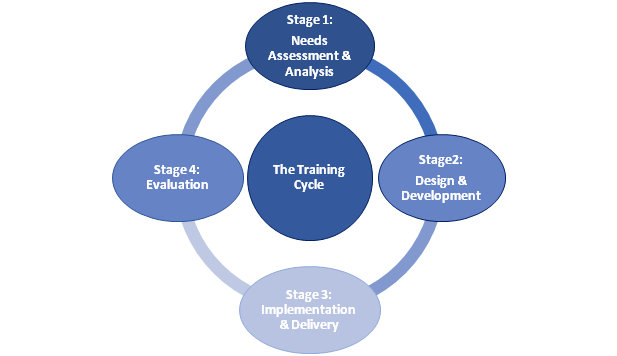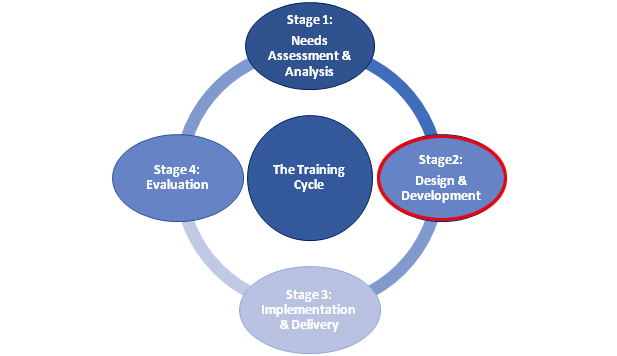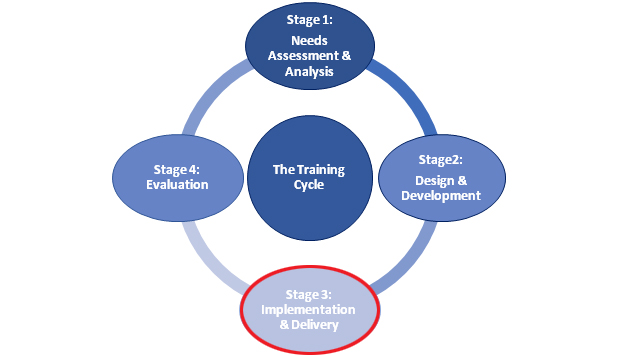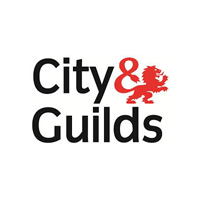The Learning and Development (L&D) function in today’s business world is emerging as an integral part of an organisation’s strategy. A greater number of businesses are recognizing the need to invest in building the capabilities of its people. L&D is a key function that requires the same rigour and attention as any other strand of corporate strategy. Well managed L&D interventions can ensure that people have the right skills at the right time to meet and exceed business needs.
L&D initiatives are generally structured as per the standard training cycle illustrated in the figure below. Various models and variations of the training cycle are used within organisations depending on the corporate intentions and business needs such as the ‘ADDIE’ model and the ‘SAT’ model but the underlying principles remain the same.

Organisations are becoming increasingly aware of the principles and processes that govern the training cycle, however, the challenge lies within the application of such programmes in the day to day work environment.
We will examine each stage of the training cycle individually to understand the key considerations for an integrated and holistic approach, and identify ways to address the challenges within the L&D domain. In the coming months, we will explore the four (4) stages of the training cycle from a strategic planning perspective through our monthly newsletters starting with “Needs Assessment and Analysis”.
Stage 1: Needs Assessment and Analysis
Training Needs Assessment (TNA) is the first stage of the training cycle. An accurate analysis of training needs plays a pivotal role in planning for and investing in tailored L&D interventions. The dilemma with a TNA is that it is based on the organisation’s perception of what its people need rather than undertaking a due diligence exercise (TNA) to identify the knowledge and skills gap that exists, limiting the efficiency and effectiveness of its people. The following guidelines summarise the key considerations that should be taken into account when carrying out a TNA exercise:
- What output does the business expect from its employees?
- Does the business strategy require specific standards of performance from its employees?
- What type of behaviours, knowledge (technical or of a commercial nature) and competencies are employees expected to demonstrate in their professional roles?
- At which proficiency level are the employees expected to perform?
- What are the expected outcomes?
- Is there a requirement to obtain a professional certification or accreditation?
- When are the employees expected to attain the required level of knowledge, skill and competency?
The strategic role of the L&D function demands that a structured process is put in place and communicated to all the managers and employees. Line managers and leadership teams are responsible for ensuring that they provide input and feedback on the individual development needs of employees, which can also be captured through annual performance reviews.
It is important that the medium used for carrying out a TNA is selected carefully keeping in mind ease of use, collation, consolidation, retrieval and analysis of data. Use of systems is recommended where companies have an HRMS or an alternative automated system in place; however, a simple spreadsheet can be equally useful for this purpose. Once information is collected, reviewed and analysed, planning for L&D initiatives can be activated keeping in mind the following:
- Who needs to be trained and on what topic?
- The target groups, levels & number
- Specialization & certification
- How will training be delivered?
- What types of training interventions can be used? e.g. outsourced, in-house, OJT (on the job training), online, seminars / webinars and / or blended learning options
- Available working days
- Expectations of outcomes
- Methods to measure & evaluate
- Cost & budget
Consolidation and analysis of the information listed above can result in the successful articulation of the training calendar detailing the types of trainings, programmes, dates and locations.
The result of incorporating a structured TNA process is the development of a training plan with interventions that are specific to the individual’s development needs and organizational requirements. Systematic planning of the TNA process provides clarity and transparency in identifying who needs to be trained and on which subject, enabling organizations to calculate the associated costs and the return on their investment.
Be a Mentor and give back to ‘strengthen social responsibility in the private sector’.
‘Leaders for Tomorrow’ facilitated by PeopleFirst HR Consultancy
2017 has been announced as ‘The Year of Giving’ by HH Sheikh Khalifa bin Zayed Al Nahyan and in support of the theme; strengthening social responsibility in the private sector, PeopleFirst is launching a mentoring programme to support young individuals who are embarking on their careers and entering the world of work.
‘Leaders for Tomorrow’, is a ‘not for profit’ scheme which aims to provide young graduates, who are just embarking on their careers, support and guidance from a network of Mentors that is made up of successful and experienced working professionals from a diverse range of industries / businesses.
The vision of the ‘Leaders for Tomorrow’ programme is to support the development of young individuals in their journey to become future business / industry leaders that will create rewarding and challenging work environments in which people and communities can thrive.
Our mission is to give all young graduates across the GCC an opportunity to benefit from a strong mentoring relationships that will help them grow and develop their skills and potential, and support them in their journey to become thriving, productive and engaged professionals.
“Mentoring and coaching is an area of leadership that I am very passionate about and when I heard about the UAE making 2017 ‘The Year of Giving’, I felt this was a fantastic opportunity to launch the ‘Leaders for Tomorrow’ programme. I see the ‘Leaders for Tomorrow’ programme as a vehicle to connect experienced, professional people from different industries with young individuals who are embarking on their careers and thus, collectively, contribute to the development of our future workforce. Over the years, I have had the pleasure of working with, and learning from, so many talented and experienced people which has helped me tremendously, and I believe that creating similar opportunities through a network of Mentors will have a huge impact on young people starting their careers,” says the Founder and Managing Director of PeopleFirst HR Consultancy, Asma Bajawa.
Mentoring has many benefits for both the Mentee and Mentor. For the Mentee, this can give a young individual access to knowledge, skills, relationships and contacts that they would not otherwise have, but most importantly it provides a safe, trusted environment for them to discuss or share issues that may affect their professional and personal development. Likewise, for the Mentor, knowing they are able to shape and influence an individual’s growth and contribute to their development by giving them the support, guidance and advice needed is in itself the most rewarding result.
The ‘Leaders for Tomorrow’ programme will be managed end to end by PeopleFirst and provide a structured framework, with clear guidelines that will include but not be limited to the following:
- Establishing a network of Mentors
- Identifying a pool of Mentees
- Defining roles and responsibilities of the Mentor and the Mentee
- Setting expectations and objectives of the Monitoring relationship
- Linking the right Mentor to the right Mentee
- Follow up and support
- Monitoring & reporting on the programme
- Free training workshops
If you are interested and willing to become a Mentor and support the development of a young graduate as part of HH Sheikh Khalifa bin Zayed Al Nahyan ‘Year of Giving’ and Strengthening Social Responsibility in The Private Sector, we would love to hear from you. There is no cost involved and all you need to do is dedicate one (1) hour of your time each month to Mentor and help build a ‘Leader for Tomorrow’.
Attributes of a Mentor
- Leads by example
- Motivates and inspires others
- Gives advice based on experience
- Gives open and honest feedback
- Has a good network of people to tap into
- Is a seasoned professional and is able teach what can’t be learnt in the classroom
- Has time and energy and the desire to help others achieve and succeed
If you’re interested in being a Mentor and being a part of Leaders for Tomorrow contact:
Mohsin Bajawa
Operations Director │ T: +971 4 447 5210│ M: +97150 509 2366│ mohsin@peoplefirstme.com
In last month’s newsletter we started to examine each specific stage of the training cycle to understand the key considerations for an integrated and holistic approach to L&D. Following on from the March edition of the newsletter which focused on Stage 1 – ‘Needs Assessment & Analysis’, we will now discuss Stage 2 – ‘Design & Development’
As a reminder, the four stages of the training cycle are illustrated below:

Stage 2: Design and Development
Whether an organisation has the in-house capability to design and develop Learning & Development (L&D) interventions, or decides to outsource to a third party provider, the principles of design and development in the L&D context remain the same. During stage 2, it is important to focus on and ensure, that any L&D interventions are aligned with the outcomes of the TNA.
Designing L&D interventions can be compared to planning for a trip. Just as it is important to map out the best possible route to reach the final destination, it is important to map out the best methodology to design L&D interventions that will meet the objectives. Design can be seen as an outline of all the “what, where, who, when and how” details of a training intervention.
Here are some tips that should be considered when designing and developing L&D interventions:
Training evaluation – Before initiating the design and development of an L&D intervention, it is important to consider how this will be evaluated and what tools and techniques will be used to measure the effectiveness of the intervention.
Participant profile – The size of the target audience and their specific skills/ability level should be considered in the design and development phase to ensure that the learning tools and resources used are fit for purpose and the content is differentiated to suit the participants’ needs
Instructional strategies – Prior selection of instructional strategies adds substantial value to the effectiveness of the design. In making these selections, it is important to ensure that that the chosen instructional strategies meet the needs of the target audience. In recent years we have seen significant changes in L&D trends and in particular in delivery styles, where face to face lecture style training has now been replaced with more interactive, experiential learning and hands-on digitally driven tools.
Training logistics – Training logistics is an important aspect of the design and development phase which is often forgotten or left to the last minute. Early consideration to this aspect of the design and development of an L&D intervention can have a significant impact on the overall participant experience. Logistics need to be carefully planned to ensure the training environment is compatible with the training design, which contributes to maximizing engagement and the overall participant experience. Logistical considerations can include but are not limited to the following:
- Scheduling (courses & participants)
- Communication with participants (invites)
- Training structure & duration
- Days of the week/time of the day
- Duration of each session
- Location
- Training materials
- Resources & collaterals
- Cost/participant expenses
After considering the aspects listed above, the next step would be to develop a detailed session plan to organise the design in a structured manner. This helps to shape the design by planning out specific step by step actions of the training content and how this training will be delivered. A well written session plan can contribute significantly to ensuring that the training methodology and resources are aligned to the learning outcomes.
Designing the structure and content of an L&D intervention is a very detailed activity which can be very time consuming. In fact the design and development phase tends to be the most time consuming phase of the training cycle.
Design and development requires critical thinking and creativity. In today’s digitally connected world, content is readily available at a click of a button, and often free of charge so time spent in researching and using available content to create viable course designs can often be more worthwhile creating something from scratch. However it is important to remember to take consent prior to using content properly and referencing material/content where necessary.
What is an HR Health-Check and how can this benefit my organisation?
What is an HR Health-Check?
An HR Health-Check is a diagnostic exercise that is used to get a detailed understanding of how an HR department is functioning and how effective it is in achieving its overall purpose and departmental objectives. Ideally, an HR Health-Check should investigate all aspects of the HR function which includes but may not be limited to:
• HR strategy
• HR organisation structure
• Roles and responsibilities of the HR function
• HR capability assessment (individual & team)
• HR policies and policy implementation
• HR processes and procedures
• HR service delivery
• Employee records and data integrity
• Compensation and benefits
• Recruitment and selection
• Training and development
• Career development
• Performance management
• HR systems
• HR metrics
• HR work environment
A well-executed Health-Check will not only provide a detailed view on the ‘current state’ but will also identify specific gaps that need to be addressed to drive optimal performance of the HR function. An HR Health-Check should ideally result in prioritized recommendations that address the specific gaps identified through the audit process.
What are the benefits of an HR Health-Check?
Unlike an ‘internal audit’ that focuses primarily on auditing HR processes, an HR Health-Check takes a broader and more strategic perspective investigating all aspects of the HR function and benchmarking the ‘current state’ against the following aspects:
• Legal and regulatory compliance
• Alignment to company policies and procedures
• Alignment to business strategy / strategic objectives
• Alignment to HR best practices
• Industry standards
The key benefits of an HR Health-Check include:
• Getting an accurate, unbiased perspective of the ‘current state’ giving a factual evidence based perspective of the HR function highlighting what works well and the areas of improvement
• Assessment of the potential risks for a business in terms of legal and regulatory compliance
• Provides a formal feedback mechanism to embed continuous improvement activities
• Benchmarking against best practices
• Driving process efficiency and identification of non-value added activities
Who should carry out an HR Health-Check?
An HR Health-Check should be carried out by someone that is independent from the HR department and is experienced in all aspects of HR. Maintaining objectivity is critical and and will go a long way in ensuring credibility of the process
What triggers the need for an HR Health-Check?
An HR Health-Check can be carried out at any time and may be initiated by either internal or external factors. Whilst there is no statutory obligation to conduct this type of audit, external factors such as changes in labour regulations may trigger the need for an audit.
Triggers may include:
• Merger or acquisition takes place – the Heath-Check forms part of the due diligence process and provides critical information that helps in the integration and streamlining of the HR function when two companies come together in this way.
• Certifications or accreditations – e.g. ISO, JCI etc., can drive the need to review HR practices and align these to specific standards.
• Growth – organisations that are experiencing or planning for growth, often conduct an HR Health-Check when they realise that the HR function may not be fully equipped to support the growth strategy.
• Cost reductions – equally in times of business uncertainty and economic instability, many organisations conduct Health-Checks in search for opportunities to reduce costs and drive efficiency.
• Assessment of the HR function – reviewing the adequacy of the HR strategies, policies, processes, procedures and systems will help organisations to remain abreast of what is working well and where improvements are needed.
Whatever the reason, an HR Health-Check provides a strong basis for driving change and making improvements in this key support function. Establishing and measuring performance against key HR metrics e.g. attrition rates, engagement levels etc., can help organisations to instill a mindset of continuous improvement which can reduce the need for in depth Health-Checks or audit as this serves as a regular temperature gauge.
What is involved in conducting an HR Health-Check?
The first step of conducting an HR Health-Check is the review and data collection phase. This can involve qualitative and quantitative data which often requires a lot of interaction with people within the HR team. This can prove to be challenging at times, therefore it is important to communicate and engage people in the process in an open and transparent manner. The Health-Check can in some instances be dependent on people providing accurate information so it is important to explain why the process is being carried out, how the results will be used and how this benefits not only the HR department but the wider organisation. Remember a disengaged respondent, who is suspicious of the motives of the Health-Check is unlikely to support the process in an open manner, therefore transparency and tact is key to addressing this potential issue.
Once the data has been reviewed this should result in a gap analysis exercise and supporting recommendations which are prioritized based on the impact to the business.
What happens after the Health-Check?
The value of conducting an HR Health-Check is really derived from implementing the recommendations resulting from the process. This can take time and of course will depend on various things such as strategic priorities, budgets, available skills and resources etc., therefore the planning and prioritization is a decision that should be made with the business and not in isolation.
How can we help you?
PeopleFirst has extensive experience in successfully conducting HR Health-Checks for large, small and medium sized organisations and across a diverse range of industry sectors. We adopt a consultative style and work with our clients to conduct detailed audits and take a hands on approach support the implementation of recommendations.
If you have questions, please do not hesitate to contact us:
T: +971 4 4475210
www.peoplefirstme.com
info@peoplefirstme.com
It is no secret that the holy month of Ramadan has a huge significance in the UAE. With Ramadan right around the corner, here’s what you need to know about the holy month so that your workplace is aligned with the law as well as the norms and expectations of the country and the UAE culture.
First things first: What is Ramadan?
Ramadan is the holy month of the Islamic calendar, during which Muslims fast for 30 days from sunrise till sunset. It is the month of charity, worship and self-restraint.
This year, Ramadan will begin on Saturday, 27th May, bringing with it considerable changes in our normal work routines. This article explores the impact of Ramadan in the workplace.
What is Suhoor?
Suhoor is an Islamic term used for the early morning meal that Muslims consume before fasting. This meal is consumed right before sunrise and is meant to keep fasting Muslims energized until it is time for Iftar.
What is Iftar?
Muslims break their fast at the end of the day i.e. at sunset. The Islamic term for the meal consumed to break the fast is Iftar.
How is the working day affected by Ramadan?
As per Article 65 of the UAE labour law, all employees, Muslim and non-Muslim, are entitled to a 2 hour reduction in the daily working hours. The daily hours can be reduced by either starting work later or finishing earlier at the end of the day however this will depend on the timings set by the employer.
In instances where overtime is required during Ramandan, this cannot be imposed by the employer and the employee must agree to take on any extra hours. In this instance, overtime is payable as per the overtime rules for any hours worked over and above the reduced working day.
How are nursing breaks affected by Ramadan hours?
A female employee who has returned from maternity leave and is nursing her child will be entitled to a nursing break of up to 1 hour a day. This will be in addition to the 2 hour reduction which applies to all employees.
What impact does Ramadan have on the work environment?
- Eating, drinking and smoking are prohibited in public places, therefore the employer should designate a specific area which is out of sight, where employees who are not fasting can eat or drink during working hours
- Fasting can be physically and mentally tiring and therefore may affect concentration and energy levels during the day
- All employees are encouraged to pay particular attention to how they dress in Ramadan and are encouraged to dress modestly to show respect to the country’s culture
Many organisations plan a get together for Iftar with their employees and celebrate the joy of breaking the day’s fast. This makes for a great way to bond with the team and enjoy the Ramadan festivities.
PeopleFirst HR Consultancy attended the Achieving Women Forum 2017, organised and hosted by Entrepreneur Magazine.
Earlier this month PeopleFirst HR Consultancy attended the third edition of the Achieving Women Forum hosted by Entrepreneur Magazine, addressing the methodology of business.
The topics of discussions included:
- ‘Keys to the Kingdom: Getting into the C-Suite,’
- ‘The Hard Sell: Building Your (And Your Business’) Brand Value’
- ‘Scaling through Sales: Funding Your Enterprise’s Growth With Your Customers’
The panellists presented their own insightful experiences on attaining the keys to the C-suite, cultivating and improving brand identity, targeting the right audience and employing the correct marketing strategies. The forum showcased some very successful and inspiring women within the UAE. Among these were:
- Lubna Qassim: Executive Vice President and Group General Counsel
- Donna Benton: Launched and Founded ‘The Entertainer’
- Alanoud Faisal: Co-founder of Invert.com, a London-based digital platform, Advisory Chairwoman of ella, a Dubai-based media platform for women in the Middle East, Founding Member of Makeen, a not-for-profit Saudi business incubator for women and a Global Ambassador for 10KSA, a world record breaking holistic health awareness and education initiative in Saudi Arabia.
These women and the other panellists portrayed their proven perseverance to achieve leadership roles in the MENA business sector.
Ultimately, the forum called upon all working women to discover, network and connect with one another to help and support each other to elevate them on a personal and professional level.
Learning and Development: A Strategic Function:
Stage 3: Implementation and Delivery
Over the past two months, we have reviewed the first two stages of the training cycle with the aim of creating a better understanding of the key aspects of an integrated and holistic approach to L&D. Following on from April’s edition of the newsletter which focused on stage 2 of the training cycle – Design and Development, we will now spend some time to discuss stage 3 ‘Implementation & Delivery’. As a reminder, the four stages of the training cycle are illustrated below:

One of the key challenges for many L&D professionals during the implementation and delivery stage is how to engage participants in a way that is meaningful and productive. Regardless of the medium used for this, albeit digital or face to face, the training environment must be such that participants feel safe, comfortable and free to express themselves openly which are all key ingredients to aid the learning process.
Planning for implementation and delivery should ideally begin during the Design stage. This starts with understanding the needs and background of the target audience which includes their previous experiences, their skills, their knowledge and their specific goals and expectations from the learning intervention which can directly impact their motivation and participation.
In an ever evolving world of L&D, more and more professionals are connecting through social interfaces to share expertise and these interfaces are now considered obvious and progressive channels for engaging learners. Learning through mediums such as e-learning, social learning platforms, on the job training, and peer learning are all becoming more and more popular compared to the traditional trainer led, classroom based approach. Some of the benefits of these evolving mediums include cost effectiveness, efficient use of time and resources, independent and self-directed learning and enhanced knowledge sharing. One of the potential pitfalls however, to watch out for when using social and digital learning platforms is to ensure the authenticity of the content and source.
Where trainer led, classroom based, training is necessary, an appropriate mix of interactive activities and methods that offer differentiated learning and complement theoretical concepts should be considered. This may include, but not be limited to, hands-on individual activities, group exercises, presentations, simulations, case study analysis etc. The table below (adapted from Calao, 2011) presents a comparative analysis of the most commonly used training methods:

For classroom based training, when it comes to trainer selection, it is important to consider where this expertise might come from. In addition to the obvious external sources, organisations should consider internal resources which can prove to be a more cost effective alternative and bring with them specific subject matter expertise and an understanding of the business context. This can also be a very good development opportunity for your employees.
The implementation and delivery aspect of the overall training cycle is the most impactful in many ways and contributes significantly to the overall participant experience and the learning process.
Learning and Development: A Strategic Function, Stage 4: Evaluation
Over the past few months, we have been looking at the stages of the training cycle with the aim of creating a better understanding of L&D as a strategic function. In this newsletter, we talk about the final stage of the cycle i.e. Evaluation, which is undoubtedly an area of interest for all businesses. As a reminder, the four stages of the training cycle are illustrated below:

Although Evaluation is the final stage of the training cycle, it is very closely linked to stage 1 which is the Needs Assessment and Analysis stage. This link is important as all L&D activities should begin with a clear understanding of the business priorities and the expected outcomes, and end with a robust mechanism to measure the impact of the investment. It is important to measure the effectiveness of any L&D intervention at both an organisational and individual level as this can actually help to steer the investment in terms of time, money and effort so that it complements and supports the actual needs of the business. This calls for the L&D function to evolve into a more consultative role and consider business priorities as the basis of employees’ development.
The outcome of the Needs Assessment (stage 1 as discussed in our March newsletter), determines what the business expects to achieve at the end of the training. It is the responsibility of the L&D department to ensure that there is a process, metric and tool in place to measure the expected outcomes. The two most commonly used models for the purposes of evaluation are:
- The Kirkpatrick Model of Evaluation by Donald L. Kirkpatrick
- The Phillips ROI Methodology by Jack J. Phillips PhD
Both models are based on the notion that providing the individual with an opportunity to learn triggers a chain reaction that can confirm effectiveness of the intervention. A comparison of the two models is given in the table below:
| Level |
Kirkpatrick Model |
Phillip ROI Methodology |
| 1 |
Reaction |
Reaction, satisfaction, and planned application |
| 2 |
Learning |
Learning |
| 3 |
Behaviour |
Behaviour, application, implementation |
| 4 |
Result |
Business impact |
| 5 |
Return on expectations (ROE) |
Return on Investment (ROI) |
Adapted from: http://www.elearninglearning.com
Which one of the two models is more effective and relevant to the business is debatable. Both models address Evaluation at similar levels and ultimately assess the effectiveness by analysing the impact on the business. Both models are being challenged for appropriateness and effectiveness by leading L&D researchers now, but in actual fact most businesses only apply Level 1 of the models which is not sufficient to evaluate the impact on the business in financial or non-financial terms.
Phillips sees Return on Investment (ROI) as a separate level because it requires a new set of data that is not found in the other levels of Evaluation. The ROI level in the Phillips approach indicates that the impact of training should be evaluated in isolation to ensure results are tangible and credible. Unlike Phillips, the Kirkpatrick approach does not see Return on Investment (ROI) as a separate level and focuses on the business partnership approach. The Kirkpatrick model emphasizes the need to focus on collective efforts to accomplish return on stakeholder expectations without attempting to isolate the effects of training. That is why Return on Expectations (ROE) is being viewed as the fifth level of the Kirkpatrick model.
ROE is a collaborative agreement that unites an organisation in working towards a common goal. It is becoming quite popular in progressive organisations but it is important to understand that even though the measurements for ROE may not be as scientific and formulaic as ROI, it is not very different from ROI. ROE can in fact be a strong measurement that may include a formal metric based ROI calculation if that is what the business stakeholders expect. The key is to understand the objectives of L&D intervention and define a metric that can be used to monitor and track progress. Some examples of typical ‘expectations’ converted into successful outcomes are:
- Revenue from new customers
- Increased operational efficiencies with decreased training costs
- Reduced turn-around times
- Increased retention of top talent
Many people struggle with implementing ROE / ROI because they do not always understand the business expectations and can overlook the flaws of the process. It is important to avoid getting caught up in the use of jargon as this can impact the credibility and substance of the training and the business objectives. Asking the right questions such as “What will success look like to you?”, “What is the expected outcome?” etc. can help to convert broad and un-quantified expectations into observable and measurable indicators. The focus of ROE is on self reflection to address identified gaps in business skills and desired level of competencies.
Evaluation involves ‘the formal or informal assessment of the quality and effectiveness of an employer’s L&D provision, usually either by some measure of the merit of the provision itself (…) and/or by monitoring its impact (…)’ (CIPD 2015). Whether you want to focus on ROE or potentially calculate ROI, just like so many things in life, it all depends. In this case, it all depends on the goals of your Evaluation, the metrics you intend to use to measure success, and the data your stakeholders need. Regardless of the model used by your organisation, the important consideration is what is the business aiming to achieve from training?
It could be argued that many L&D functions have been caught up in administrative activities for far too long. Therefore it is now crucial for L&D functions, to break away from the monotony of training administration and think of development as a function that is embedded in the strategic intention of the business so that it can serve as the key driver of the organisation’s success.
PeopleFirst HR Consultancy shortlisted as a finalist for the prestigious CIPD People Management Awards 2017
We are delighted to announce that PeopleFirst HR Consultancy has been shortlisted as a Finalist for Best HR/L&D Consultancy in this year’s CIPD People Management Awards.
The CIPD People Management Awards are the most prestigious awards in the HR industry and are considered to be the “Oscars” of the HR profession. The Award rewards and celebrates the outstanding achievement in people management and development, honouring the valuable contribution that HR and L&D professionals make to the success of an organisation.
Our entry “Project Runway” describes a project undertaken for a high-profile client based in the Sultanate of Oman and is linked to the largest capital investment project ever undertaken in the Sultanate. The strategic impact of the project will contribute to the development of the Tourism and Logistics sectors in Oman which are poised to become key economic drivers for the Sultanate.
As part of the final evaluation process, our team has been invited to London to present to a panel of elite judges who will scrutinise our submission and question our team along with our client, giving us an opportunity to bring our written entry to life. The winners will be announced on 26th September 2017.
PeopleFirst is honoured to be recognised by our peers and have our fingers crossed for the results.
Driving efficiencies through Payroll & HR Services outsourcing
As the economic climate takes time to recover, it isn’t surprising to see more and more businesses, large and small, across the region, continually looking at ways in which to reduce costs and increase business efficiency. This is definitely a positive trend that was triggered by the external economic environment, however, this is also something that all businesses should be paying attention to, in good and bad times, as this can have a direct impact on the bottom line.
So what can HR do to make its contribution to business efficiency and cost savings? Day-to-day HR operations are heavily burdened with HR administrative activities that are more often than not still carried out manually with little or no automation. Payroll & HR Services outsourcing is a practical, easy to implement solution that can help many HR departments drive efficiencies and reduce costs, freeing up internal resources to focus on more value-added activities that harness employee engagement, contribute to the delivery of strategic objectives and drive capability development to support top line growth.
Outsourcing could not be simpler.
PeopleFirst provides a Payroll and HR services outsourcing solution via an online cloud based platform that takes care of all your current administrative activities related to Payroll and HR administration also known as HR services. Our outsourcing solution is a fully automated solution covering all aspects of the HR services lifecycle from on-boarding through to separation. This includes leave management, time and attendance planning/management, payroll & pension administration, performance management, recruitment and & HR analytics.
Key features of our Payroll and HR Services outsourcing solution are summarised below:
- An online HRMS cloud based portal fully customized to your organization’s HR policies and brand
- An Employee Self-Service (ESS) & Manager Self-Service (MSS) portal with real time updates
- Easy access through your PC, laptop or mobile
- Compatible with leading accounting and ERP systems
- A dedicated consultant also known as an HR Services Partner (HRSP) comes as part of our outsourcing solution to handle any face-to-face HR services related issues and provide management updates when needed
Through our end-to-end Payroll and HR services outsourcing solution, we assist companies with streamlining their HR services activities, process all aspects of monthly payroll, automate letter generation, manage employee’s documents, generate pay slips and MIS & HR Analytics reports. Our online solution is complimented by a dedicated HR Services Partner who will act as the single point of contact and will provide professional HR support and guidance where needed allowing you to focus on tasks critical to the business.


Our solution can deliver tangible benefits that will add real value to your organisation. This includes:
User-friendly system with mobile functionality
Our system is trusted and easy to navigate supporting the full HR lifecycle. Users have access to a web helpdesk to assist employees with HR related queries.
Reduced cost & time – No capital investment required
Inefficient HR service activities add to your operating costs and our solution provides the opportunity for businesses to maintain minimal or zero in-house HR services resources whilst having access to professional HR expertise and a fully comprehensive HRMS platform. Our Payroll & HR outsourcing solution facilitates organizational agility and enables companies to experience measurable reductions in cost, time and resources.
Increased efficiency & quality
Clients can benefit from improved efficiency and enhanced service levels by outsourcing their transactional HR activities and services. Our offering ensures legal and regulatory compliance, compliance with WPS and supports accurate and on time payroll processing and automated approvals and controls.
Access to expertise
We adopt a partnering approach by dedicating a skilled and experienced PeopleFirst resource to partner with the client, providing access to HR expertise ensuring business needs are fully secured. We continually invest in our people, processes and technology to provide clients access to the latest skills, capabilities and professional HR knowledge.
Capacity for the HR function to operate more strategically
HR outsourcing frees up internal HR resources to focus on the strategic needs of the business, adding value where it is needed most. This process will enable in-house HR teams to transform themselves from a ‘reactive’ to a ‘proactive’ function and partner the business with the sole objective of developing capabilities, driving performance and business growth.
PeopleFirst’s Payroll & HR outsourcing solution is designed to help you transform the way your HR meets the needs of the business with enhanced efficiency and productivity.
For any queries please contact PeopleFirst on: info@peoplefirstme.com















